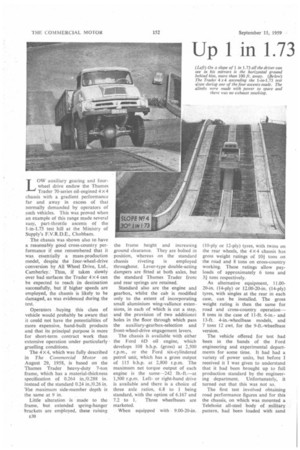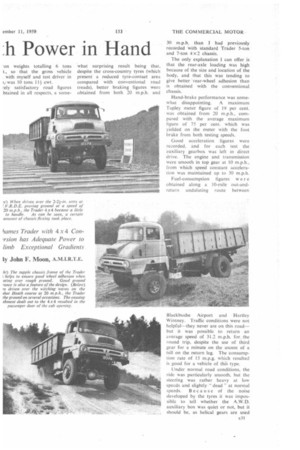Up I in 1.73 h Power in Hand
Page 92

Page 93

Page 94

If you've noticed an error in this article please click here to report it so we can fix it.
ly Join] F. Moon, A.M.I.R.T.E. LOW auxiliary gearing and fourwheel drive endow the Thames Trader 70-series oil-engined 4X4 chassis with a gradient performance far and away in excess of that normally demanded by operators of such vehicles. This was proved when an example of this range made several easy, part-throttle ascents of the 1-in-1.73 test hill at the Ministry of Supply's F.V.R.D.E., Chobham.
The chassis was shown also to have a reasonably good cross-country performance if one remembered that it was essentially a mass-production model, despite the four-wheel-drive conversion by All Wheel Drive, Ltd., Camberley. Thus, if taken slowly over bad surfaces the Trader 4 x4 can be expected to reach its destination successfully, but if higher speeds are employed, the chassis is likely to be damaged, as was evidenced during the test.
Operators .buying this class of vehicle would probably be aware that it could not have the potentialities of more expensive, hand-built products and that its principal purpose is more for short-term contract work than extensive operation under particularly , gruelling conditions.
The 4 X 4, which was fully described in The Commercial Motor on August 29, 1958, is based on the Thames Trader heavy-duty 7-ton frame, which has a material-thickness specification of 0.264 in./0.288 in. instead of the standard 0.24 in./0.26 in. The maximum side-member depth is the same at 9 in.
Little alteration is made to the frame, but extended spring-hanger -brackets are employed, these raising E30
the frame height and increasing ground clearance. They are bolted in position, whereas on the standard
chassis riveting is employed throughout. Lever-type double-acting dampers are fitted at both axles, but the standard Thames Trader front and rear springs are retained.
Standard also are the engine and gearbox, whilst the cab is modified only to the extent of incorporating small aluminium wing-vallance extensions, in each of which is cut a step, and the provision of two additional holes in the floor through which pass the auxiliary-gearbox-selection and front-wheel-drive engagement levers.
The chassis Is available with either the Ford 6D oil engine, which develops 108 b.h.p. (gross) at 2,500 r.p.m., or the Ford six-cylindered petrol unit, which has a gross output of 115 b.h.p. at 2,800 r.p.m. The maximum net torque output of each engine is the same-242 lb.-ft.--at 1,500 r.p.m. Leftor right-hand drive is available and there is a choice of three axle ratios, 6.8 to 1 being standard, with the option of 6.167 and 7.2 to 1. Three wheelbases are marketed.
When equipped with 9.00-20-in. (10-ply or 12-ply) tyres, with twins on the rear wheels, the 4 X4 chassis has gross weight ratings of 101 tons on the road and 8 tons on cross-country working. These ratings allow payloads of approximately 6 tons and 31 tons respectively.
As alternative equipment, 11.0020-in. (14-ply) or 12.00-20-in. (14-ply) tyres, with singles at the rear in each case, can be installed. The gross weight rating is then the same for road and cross-country operation8 tons in the case of 11-ft. 6-in.and 13-ft. 4-in.-wheelbase models, and 7 tons 12 cwt. for the 9-ft.-wheelbase version.
The vehicle offered for test had been iii the hands of the Ford engineering and experimental departments for some time. It had had a variety of power units, but before I received it I was given to understand that it had been brought up to full production standard by the engineering department. Unfortunately, it turned out that this was not so.
The first test involved obtaining road performance figures and for this the chassis, on which was mounted a Telehoist all-steet body of military pattern, had been loaded with sand 'on weights totalling 6 tons t., so that the gross vehicle with myself and test driver in 7,was 10 tons 1111 cwt.
rely satisfactory road figures btained in all respects, a some what surprising result being that, despite the cross-country tyres (which present a reduced tyre-contact area compared with conventional road treads), better braking figures were obtained from both 20 m.p.h. and 30 m.p.h. than I had previously recorded with standard Trader 5-ton and 7-ton 4x2 chassis,
The only explanation I can offer is that the rear-axle loading was high because of the size and location of the body, and that this was tending to give better rear-wheel adhesion than is obtained with the conventional chassis.
Hand-brake performance was somewhat disappointing. A maximum Tapley meter figure of 19 per cent. was obtained from 20 m.p.h., compared with the average maximum figure of 75 per cent. which was yielded on the meter with the foot brake from both testing speeds.
Good acceleration figures were recorded, and for each test the auxiliary gearbox was left in direct drive. The engine and transmission were smooth in top gear at 10 m.p.h., from which speed constant acceleration was maintained up to 30 m.p.h.
Fuel-consumption figures were obtained along a 10-mile out-andreturn undulating route between
Blackbushe Airport and Bartley Wintney. Traffic conditions were not helpful—they never are on this road— but it was possible to return an average speed of 31.2 m.p.h. for, the round trip, despite the use of third gear for a minute on the ascent of a hill on the return leg. The consumption rate of 15 m.p.g. which resulted is good for a vehicle of this type.
Under normal road conditions, the ride was particularly smooth, but the steering was rather heavy at low speeds and slightly " dead" at normal speeds. Because of the noise developed by the tyres it was impossible to tell whether the A,W.D. auxiliary box was quiet or not, but it should be, as helical gears are used throughout. Engine noise was subdued, as is normal with Trader chassis.
For the second day's testing the payload was reduced by 2 tons 91+ cwt. to bring the gross weight, complete with driver and passenger, to 8 tons 2i cwt.—slightly above that recommended by the Ford Motor Co., Ltd.
It had been arranged that we should spend a morning at the F.V.R.D.E. testing centre and the first item on the programme was to assess gradient performance. This work was started on slope No. 1, which has a gradient of I in 4, and the A.W.D. driver brought the vehicle down to the half-way mark, after which I took over the wheel to make a reverse restart up the gradient.
The Unexpzeted I selected reverse in the normal manner, opened the throttle, engaged the clutch and eased the hand brake off, but nothing happened except that the engine stalled. This performance was repeated until I eventually discovered that the vehicle was not even going to roll down the hill with the hand brake released.
This led to the suggestion that possibly a forward ratio in addition to reverse ratio had somehow managed to become engaged in the main gearbox, a -fault whicli had previously been experienced with another type of vehicle. The Ford representative who was with us had never heard of it in connection with the Trader, and it was quite new to me also.
After a certain amount of labour at a somewhat tiring angle we eventually managed to disconnect the cardan shaft between the main and auxiliary boxes, so thatthe 4 X 4 could be coasted down the slope and the inside of the gearbox inspected on the level. The initial assumption was correct: second gear and reverse were both firmly engaged.
Non-stop Up 1 in 3 Two hours later, however, all was well and hill-climbing tests were resumed. This time I decided to leave the 1-in-4 slope alone for a while, so we tackled the 1-in-3 section, where a non-stop ascent was made comfortably in bottom gear with the high auxiliary ratio engaged and frontwheel drive disengaged. The 4 x 4 was turned round at the top and, facing down the hill. it was stopped. The hand brake was found to be satisfactory, following which a smooth reverse restart was carried out without clutch slip.
After turning round at the bottom of this slope the vehicle was driven hack to the half-way mark and there E32 stopped. Once again the hand brake held it, although only after the brake had been helped on with the foot brake. It was just possible to make a restart in bottom gear, high auxiliary.
The third slope of 1 in 2 was out of action because of resurfacing, so slope No. 4-1 in 1.73—was then tackled. With low auxiliary engaged, four comfortable, non-stop, bottomgear ascents were made, using just enough throttle to avoid wheelspin, at a speed of about 3 m.p.h. Fortunately, the engine did not falter once during this ascent.
This restored my confidence sufficiently to persuade me to take the vehicle back to the 1-in-4 hill, where a non-stop climb was made easily in second gear, low auxiliary, having not quite managed to reach the top in second-high. Both facing up the hill and down it, the hand brake was satisfactory and reverse-high and second-low restarts were carried out smoothly.




























































































































































